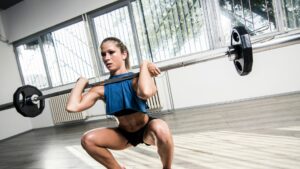Front squats, often hailed as one of the fundamental exercises in strength training, offer an incredible array of benefits for fitness enthusiasts and athletes alike. This particular squat variation is a cornerstone in many workout routines, but what sets it apart from the conventional back squat? How do front squats work, and what are the unique advantages they offer?

What Are Front Squats?
Front squats, as the name suggests, involve holding the weight in front of your body rather than across your upper back, as done in back squats. The barbell is positioned on the front deltoids with the elbows lifted high, creating a secure platform to perform the squat movement.
Mechanics of Front Squats
Body Positioning
The mechanics of the front squat rely on proper body positioning. To execute it effectively:
The torso remains more upright compared to back squats.
The core engages intensely to maintain an erect posture.
The knees travel forward more, reducing the stress on the lower back.
Muscle Engagement
Front squats target various muscle groups, including:
Quadriceps: Actively engaged throughout the movement.
Glutes: Work in tandem with the quads to drive the upward movement.
Core Muscles: Constantly engaged to stabilize the torso.
Upper Back and Shoulders: Contract to support the weight.
Benefits of Front Squats
Improved Posture and Core Strength
The front squat demands exceptional core stability, which, over time, contributes significantly to improved posture and core strength.
Enhanced Quadriceps Development
The positioning of the weight in front places greater emphasis on the quadriceps, aiding in their development and strength gains.
Reduced Lower Back Stress
Compared to back squats, front squats are gentler on the lower back due to the more upright torso position.
Tips for Perfecting Front Squats
Master the Rack Position: Practice holding the barbell in the front rack position comfortably before loading weight.
Focus on Form: Prioritize technique over weight. Maintaining proper form is crucial to prevent injury.

Gradually Increase Weight: As proficiency improves, incrementally add weight to your front squat.
So.
Front squats are a valuable addition to any workout routine. They target multiple muscle groups, improve core strength, and offer an alternative to back squats, making them an essential exercise for fitness enthusiasts and athletes alike.
Ready to incorporate front squats into your routine? Begin gradually, prioritize proper form, and experience the myriad benefits this exercise has to offer.
Remember, consistency and proper technique are key to reaping the rewards of this powerful exercise!
Let’s dive deeper into the intricacies of front squats
Mastering Front Squats: Techniques and Variations &
Refining Your Front Squat Technique
Grip and Bar Placement
Achieving the ideal grip and bar placement is fundamental for a successful front squat:
Clean Grip: Commonly used, involves the fingertips supporting the barbell across the shoulders.
Crossed-Arm Grip: The bar rests on the front deltoids with the arms crossed, allowing for a secure hold.
Squat Depth
Front squats encourage greater depth due to the torso’s upright position:
Aim to descend until your thighs are parallel to the ground or lower, maintaining control throughout the movement.
Avoid excessive forward lean to prevent compromising form.
Common Front Squat Mistakes to Avoid
Collapsed Elbows
Allowing the elbows to drop during the movement can lead to the bar rolling forward, resulting in instability. Keep the elbows lifted throughout the exercise.
Insufficient Core Engagement
Neglecting to brace the core can compromise stability and increase the risk of injury. Focus on engaging the core muscles to maintain an upright posture.
Overemphasizing Weight Over Technique
Prioritizing heavier weights without mastering proper form increases the likelihood of injury. Focus on technique and gradually increase weight as proficiency improves.
Variations and Progressions
Goblet Squats
An excellent introductory exercise, goblet squats mimic the movement mechanics of front squats using a kettlebell or dumbbell held at chest level.
Zercher Squats
In Zercher squats, the barbell is held in the crooks of the elbows, challenging core stability and upper body strength.
Bulgarian Split Squats with Front Rack Position
This variation involves elevating one foot behind you while holding the weight in a front rack position, intensifying the exercise’s focus on each leg individually.
Incorporating Front Squats Into Your Workout Routine
Frequency and Sets
For beginners, start with 2-3 sets of 8-10 repetitions, gradually increasing both sets and weight as proficiency improves.
Complementary Exercises
Pair front squats with exercises targeting complementary muscle groups, such as deadlifts, lunges, or hamstring curls, for a well-rounded lower body workout.
Conclusion
Front squats, with their unique mechanics and targeted muscle engagement, offer a myriad of benefits for strength, stability, and overall fitness. Mastering proper technique and exploring variations can elevate your workout routine and contribute to achieving your fitness goals.
Whether you’re a beginner or a seasoned lifter, incorporating front squats into your regimen can enhance lower body strength, core stability, and overall athletic performance.
External Resources:
Front Squat Technique Guide by BarBend
Benefits of Front Squats by Men’s Health
Front Squat Variations for Strength and Mobility by Breaking Muscle
Explore these resources for in-depth insights into perfecting your front squat technique and incorporating variations into your workout routine. Remember, consistency and dedication lead to progress and strength gains.
Comparison tabular
Here’s a comparison table highlighting the differences between front squats, back squats, and goblet squats:
| Aspect | Front Squats | Back Squats | Goblet Squats |
|---|---|---|---|
| Bar Placement | Across front deltoids with elbows raised | Across upper back (trapezius muscles) | Held at chest level with a kettlebell or dumbbell |
| Torso Position | More upright | Moderate forward lean | Upright |
| Muscles Targeted | Quads, glutes, core, upper back | Quads, glutes, hamstrings, lower back | Quads, core, upper body |
| Core Engagement | High | Moderate | Moderate |
| Stress on Lower Back | Reduced | Moderate | Reduced |
| Difficulty in Technique | Requires good wrist and shoulder flexibility | Back support may aid beginners | Beginner-friendly |
| Depth Achieved | Greater due to upright torso position | Moderate | Limited by the weight |
| Variations Available | Zercher squats, Bulgarian split squats | Wide range, including low-bar and high-bar squats | Limited by the weight |
| Suitable for Beginners | Challenging due to technique and flexibility | Easier to learn with back support | Beginner-friendly |
This table should give a quick snapshot of the differences among these three squat variations, helping you decide which might suit your fitness goals and experience level best.
Wrapping up
Front squats stand as an exceptional exercise in the realm of strength training. Their unique mechanics, engaging multiple muscle groups while emphasizing core stability, make them a valuable addition to any workout routine.
Mastering the front squat technique requires dedication and patience. Prioritize proper form over weight, gradually increasing intensity as proficiency grows. Incorporating variations like Zercher squats or Bulgarian split squats can add diversity to your routine and challenge your body in new ways.
Whether you’re aiming for improved lower body strength, enhanced core stability, or overall athletic performance, front squats offer a pathway to achieving these fitness goals. Consistency, patience, and a focus on technique are key to reaping the full benefits of this powerful exercise.
So, are you ready to step up your fitness game? Start with the basics, perfect your form, explore variations, and witness the transformative impact of front squats on your strength and fitness journey!
Remember, the journey to strength and fitness is as much about persistence as it is about the exercises you perform. Keep pushing forward, stay consistent, and enjoy the rewards of your hard work!

Hey there, it’s Mike Rrsq, the Editor-in-Chief over at Jsquat.com, and I’m absolutely obsessed with all things squat fitness! I’ve been lucky enough to get some serious recognition for my work in this field. With a solid background in the fitness and wellness industry, I’ve been there right from the get-go, helping shape this website into what it is today.
You see, I’m not just the boss around here; I’m also a passionate contributor. I love sharing my insights through my articles, and trust me, they’re not your run-of-the-mill stuff. Each piece I write is a labor of love, filled with my expertise and real-world experience in the fitness universe. So, if you’re into fitness and looking for some inspiration, you’re in the right place!
Related Posts
- Can You Combine Front And Back Squats In Your Workout Routine (Explained)
You may be wondering whether it's possible to combine front and back…
- Can Zercher squats effectively substitute back squats in a workout routine
Weightlifting enthusiasts often seek variations in exercises to target muscles differently or accommodate physical limitations.…
- Do half squats offer genuine benefits in a workout routine
Squats are the powerhouse of lower body exercises, often seen as a fundamental movement for…
- Mastering Core Engagement in Front Squats: A Step-by-Step Guide
Front squats are a fantastic compound exercise that not only targets your lower body but…
- In your workout routine, is it better to start with squats or back and biceps?
Finding the optimal sequence for your workout routine can significantly impact your results. When torn…
- Are Front Squats Better To Do Than Back Squats? (5 things to know- Explained)
Are front squats better than back squats? Discover the answer to this age-old question and…
- Front Squats vs. Back Squats: Which Should a 23-Year-Old Choose
At 23, the world seems like a playground, but when it comes to fitness, choices…
- Is it advisable to incorporate squats for abs twice a week in a home workout routine
When it comes to sculpting those abs, the journey can take many paths. Squats, known…
